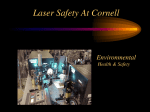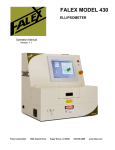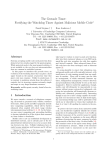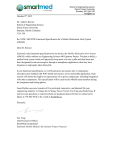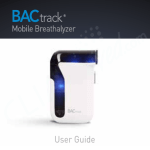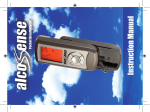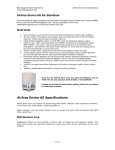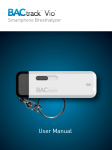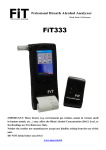Download Ritik Looned - Simon Fraser University
Transcript
School of Engineering Science – Burnaby, BC [email protected] February 17th, 2014 Dr. Andrew Rawicz School of Engineering Science Simon Fraser University Burnaby, British Columbia V5A 1S6 Re: ENSC 440/305W Functional Specification for an Impaired Driving Prevention System Dear Dr. Rawicz, Attached is the document from AlcoShield Company describing the functional specification for the Impaired Driving Prevention System. We intend to design and implement a system that would focus on preventing intoxicated individuals from operating their vehicles by terminating the ignition of the engine if they are suspected to be over the local Blood Alcohol Content (BAC) limit. The system would include a breathalyser to measure the BAC and a method to authenticate the driver. The enclosed document will provide a set of high-level requirements and specification for intended functionally and design of our proposed product. This specification will be used as a reference for our project manager and design engineers throughout the product development phase. Our accomplished team of senior engineers who are committed to this project include Moataz Billeh, Ashraf Jerbi, Ritik Looned, Mohammed Naghshineh, and Nima Soroudi. We look forward to your support over the term and if you have any questions or concerns please contact me via email at [email protected]. Sincerely, Ritik Looned Ritik Looned Chief Executive Officer Alcoshield Enclosed: Functional Specification for an Impaired Driving Prevention System School of Engineering Science – Burnaby, BC [email protected] Functional Specification for an IMPAIRED DRIVING PREVENTION SYSTEM Project Team Ashraf Jerbi Ritik Looned Nima Soroudi Moataz Billeh Mednini Mohammed Naghshineh Contact Person Ritik Looned [email protected] Issue date February 17, 2014 Submitted to Dr. Andrew Rawicz – ENSC 440 Steve Whitmore – ENSC 305 School of Engineering Science Simon Fraser University Functional Specification for an Impaired Driving Prevention System SoberJack Executive Summary Impaired driving is an unfortunate prevalent occurrence in today's society. It is estimated that 2,541 individuals were killed in motor vehicle accidents in Canada in 2010 of which at least 1,082 were impairment-related [1]. The aim of the project is to design a system which prevents any form of drunk driving while over the legislated legal limits. There are two scenarios which are targeted in our system: the first in which the user is intoxicated and thus are not allowed to operate the vehicle, and the second in which the user is sober and no immediate restrictive action is taken. The entire system would consist of a breathalyser, an ignition kill switch, a driver authentication strategy all of which would be integrated into the vehicle as an aftermarket device. While blood alcohol detection is a relatively simple task with current breathalysers in the market, the 'seller' in our system would be the user authentication feature. We are focused on designing a vigorous system which will ensure that it is the driver who is performing the breath test and not anyone else. The SoberJack device development will be broken down into 2 distinct phases. Phase 1 includes connecting breathalyser to ignition switch. After completion of Phase 1, the system should be operational and will provide the following functionalities: • • • Able to detect Blood Alcohol Content (BAC) with breathalyser Disable ignition switch if BAC is above limit via electronic circuit of the car Allow driver to start engine if BAC is below limit via electronic circuit of the car Although similar products do currently exist in the market, the major flaw they have is the lack of user authentication. They are easily able to be deceived by passengers breathing into them instead of the driver. Thus Phase 2 includes the development of the facial detection system to identify the driver. For this phase, the camera captures a certain number of the driver’s pictures as references for later identity checks [2]. The output result is fed to the Processing unit to generate data actuation signals. The SoberJack device will follow all relevant standards and guidelines from Minister of Health Canada, Canadian Standards Association, US Food and Drug Administration and other references as mentioned during this functional specification report. Copyright © 2014 | AlcoShield ii Functional Specification for an Impaired Driving Prevention System SoberJack Table of Contents Executive Summary ii List of Figures v Glossary v 1. Introduction 1 1.1 Scope 1 1.2 Intended Audience 1 1.3 Classification 1 2. System Requirements 2 2.1 System Overview 2 2.2 General Requirements 4 2.3 Physical Requirements 4 2.4 Electrical Requirements 4 2.5 Environmental Requirements (Cradle to Cradle) 4 2.6 Standards 5 2.7 Reliability and Durability 5 2.8 Safety Requirements 5 2.9 Usability Requirements 5 3. Breathalyzer 3.1 General Requirements 5 6 3.2 Physical Requirements 6 3.3 Usability Requirements 6 3.4 Safety Requirements 6 4. Camera 6 4.1 General Requirements 6 4.2 Physical Requirements 7 4.3 Electrical Requirements 7 Copyright © 2014 | AlcoShield iii Functional Specification for an Impaired Driving Prevention System SoberJack 5. Ignition Switch (Relays) 7 5.1 General Requirements 7 5.2 Physical Requirements 7 6. Processing Unit (Microcontroller) 8 6.1 General Requirements 8 6.2 Physical Requirements 8 6.3 Electrical Requirements 8 6.4 Reliability Requirements 8 6.5 Safety Requirements 8 6.6 Performance Requirements 8 7. User Interface and Notification System 9 7.1 General Requirements 9 7.2 Physical Requirements 9 7.3 Reliability Requirements 9 8. User Documentation 8.1 General Requirements 9. System Test Plan 9 9 10 9.1 Breathalyzer 10 9.2 Camera 10 9.3 Ignition switch 11 9.4 Processing Unit 11 9.5 User Interface 11 9.6 Integration test 11 10. Safety and Sustainability Analysis 12 11. Conclusion 12 References Copyright © 2014 | AlcoShield 13 iv Functional Specification for an Impaired Driving Prevention System SoberJack List of Figures Figure 1: General linkage of system 2 Figure 2: Basic control flow of the system 3 Glossary BAC Blood Alcohol Content CSA Canadian Standards Association FDA US Food and Drug Administration FPS Frames per Second ISO International Organization for Standardization MCU Micro-Controller Unit MOH Minister of Health Canada MOT Ministry of Transportation Canada PCB Printed Circuit Board Copyright © 2014 | AlcoShield v Functional Specification for an Impaired Driving Prevention System SoberJack 1. Introduction/Background The impaired driving prevention system is a novel design which is intended to deter any form of drunk vehicle operation. In fact, impaired driving is still a major concern in today's society and contributes to almost 50% of the total number of motor vehicle accidents each year in Canada [3]. Excessive and unnecessary resources are then dedicated to resolve such incidents which could frankly have been easily avoided. The financial implications of these activities resulted in an expenditure of over $20.62 billion in Canada in the year 2010 [4]. Realizing the urgent need to mitigate such accidents, the team at AlcoShield has taken up the responsibility of making the streets safer and sober with their SoberJack product. 1.1 Scope The functional specification documentation illustrates the requirements for our impaired driving prevention system. The functionalities are specified for each product development phase ranging from proof-of-concept to the final commercialized product. 1.2 Intended audience The aim of this document is to clearly highlight the features and requirements of the proposed system. All engineering team members of AlcoShield will be required to reference this text to ensure that the device complies with the listed operations. Testing and verification protocols will be designed such that it allows all aspects of the design will be carefully examined. 1.3 Product Phase Development Classification The following convention system is used to specify the functional number and the priority level, [Pn-p] A specific functional requirement where n denotes the requirement number and p indicates the priority specification. Further details on the priority level are specified below. I - High priority: must be mentioned in the completed prototype. It is aimed to illustrate the proof-of-concept of the system. II - Medium priority: necessary to meet to make the device marketable. These functions will be integrated to the prototype at the later stage of the project. III - Low priority: they will be added after meeting all higher priority functions. These additional functions could be market specific for the production versions. Copyright © 2014 | AlcoShield 1 Functional Specification for an Impaired Driving Prevention System SoberJack 2. System Requirements General overall system requirements for SoberJack are presented in this section. These include requirements with respect to safety, sustainability, reliability, performance and the operating environment. 2.1 System Overview Figure 1 below represents the general flow of information and linking of components in the SoberJack device. There are two scenarios which are targeted in our system: 1. The user is intoxicated and thus is not allowed to operate the vehicle. 2. The user is sober and no immediate restrictive action is taken. The entire system would consist of a breathalyser, an ignition kill switch, and a driver authentication strategy all of which would be integrated into the vehicle as an aftermarket device. Figure 1: General linkage of system Copyright © 2014 | AlcoShield 2 Functional Specification for an Impaired Driving Prevention System SoberJack Details of the operations follow below and are summarized in Figure 2 Figure 2: Basic control flow of the system To further enhance the functionality of the system (if all proceeds according to plan), we wish to implement a notification scheme to the local authorities upon detection of drunk driving. Wireless transmission of the driver image and car information will be sent to the law enforcement officers who can then take further corrective actions. A more thorough detection Copyright © 2014 | AlcoShield 3 Functional Specification for an Impaired Driving Prevention System SoberJack system will also target abusers who drink while they drive. They may begin driving sober and pass the breathalyser test but then later start drinking while operating the vehicle. For such individuals, a more rigours system would be in place which would perform periodic BAC checks. There are many expansion possibilities of this system but given the circumstances, we will be pursing the basic design to cover Scenarios 1 and 2. This alone will put a dent in the intoxicated driving statistics and lead to safer streets. 2.2 General Requirements [R1- I] Development costs of the device must be under $860. [R2- I] System must function without any interference with other devices. [R3- I] Proof-of-concept system must be fully functional. [R4- II] The retail price of the device shall be under $200. 2.3 Physical Requirements [R5- II] The breathalyser should not be in a static position. [R6- II] The camera shall be statically installed on dashboard. [R7- II] Microcontroller shall not be seen by the user. [R8- II] System must be enclosed and not be easily altered. 2.4 Electrical Requirements [R9- II] Device cases should allow for heat dissipation into the environment. [R10- II] The cord for the Breathalyzer power adaptor shall have a length no less than 1.5 m. [R11- III] System signal transmission range should be above 2 Km to inform authority. [R12- III] All components should operate with low voltage. 2.5 Environmental Requirements [R13- I] Device needs to work in average minimum and maximum car temperatures. [R14- I] Device needs to be able to work in minimum and maximum humidity level of car. [R15- I] SoberJack device components selection shall be done in a manner to minimize impact on nature and leave no negative effects if components are not chosen for final prototype. [R16- II] Noise generated during periods of activity shall be minimized. [R17- II] SoberJack should be constructed from environmentally friendly materials and follow the cradle to cradle cycle focusing on the possibility of reuse of materials. Copyright © 2014 | AlcoShield 4 Functional Specification for an Impaired Driving Prevention System SoberJack 2.6 Standards [R18- I] The device shall meet CSA standard Z32-04 governing Electrical Safety. [R19- I] The device shall meet FDA standard – Driving under Influence of Alcohol. [R20- I] Pictures shall not be sent to any other database unless approved by court. [R21- I] The device shall meet MOH standards – plastics regulation. 2.7 Reliability and Durability [R22- II] System must withstand all normal driving skills, e.g. turns, U-turns. [R23- II] Technical support and maintenance interval should be at least every 6 months. [R24- II] System must not crash on a regular basis. [R25- III] System MTBF should be at least 1 month. 2.8 Safety Requirements [R26- I] The device shall not cause bodily harm to the user while driving. [R27- II] The electronic components shall not cause interference with other devices. 2.9 Usability Requirements [R28- I] The device should be easy to turn on and off. [R29- I] The system is in static position except breathalyser. [R30- I] The device`s firmware shall be upgradeable by a trained person. [R31- I] The device should not obstruct driver`s attention. 3. Breathalyzer Breathalyzer plays the initial role in the system since it detects the blood alcohol first and passing this stage activates the rest of the system such as face recognition and ignition lock. The important functions of the Breathalyzers are as follow: • Detect the alcohol level in the body system • Generate a high (Pass) signal to MCU to activate the ignition system • Generate low (fail) signal and deactivating the ignition system The Breathalyzer is the most important part for the reliability and safety of the product since it’s the initial detector for the system when the driver wants to start the car. Copyright © 2014 | AlcoShield 5 Functional Specification for an Impaired Driving Prevention System SoberJack 3.1 General Requirements [R32- II] Breathalyser needs to have a notification system such as LED or alcohol level on it [R33- II] The Breathalyzer has to be affordable at approximately $100. [R34- II] The device should be able send the signal to MCU using the Arduino microcontroller. [R35- II] The voltage from the breathalyser should be reasonable (around 3.3V in order to communicate well with the MCU. [R36- III] Breathalyser should be in the camera frame during the use for the image processing purposes. 3.2 Physical Requirements [R37- II] The size of breathalyser has to be big enough so camera can detect it. [R38- III] Breathalyser has sufficiently compact such that the user can blow in it while seated and it doesn’t interfere with driving. 3.3 Usability Requirements [R39- III] Breathalyzer must not interfere with average driving conditions. [R40- III] The Breathalyzer should be powered by the cars battery. 3.4 Safety Requirements [R41- I] the alcohol level reading of the Breathalyzer should be accurate to ensure the ignition lock prevents the drunk driver from starting the car. [R42- I] the reading should have reasonably tolerances that will not affect the overall system operation. 4. Camera The camera is the main component in the face detection and recognition system. It provides visual data needed for initial and random checks of the driver’s identity. The camera captures a certain number of the driver’s pictures as references for later identity checks. The output result is fed to the Processing unit to generate data actuation signals. The following section outlines the functional requirements of camera. 4.1 General Requirements [R43-I] The cameras shall be able to be turned ON/OFF. [R44-I] The camera shall be compatible with the MCU. [R45-II] The cameras shall have infrared LED/flashlight to operate under low-light conditions. Copyright © 2014 | AlcoShield 6 Functional Specification for an Impaired Driving Prevention System SoberJack [R46-I] The cameras shall have at least 540x540p resolution for precise pictures. [R47-I] The camera shall fully cover the face of the driver. [R48-I] Camera shall not exceed the allocated budget. [R49-II] The camera must be mountable inside the car. [R50-II] The camera mounting shall not cause damage to the vehicle’s interior or discomfort to the driver and/or riders. 4.2 Physical Requirements [R51-I] The camera must be able to operate in temperatures ranging from -40 to 50 degree Celsius. [R52-II] The camera shall not dismount unintentionally. [R53-II] The camera shall have compact design. 4.3 Electrical Requirements [R54-I] The camera shall communicate with other components using dedicated cables that provide reliable connection for exchange of data. [R55-I] If required, camera shall be able to function using external battery (AA battery). [R56-II] The camera shall function using the internal power of the vehicle. 5. Ignition Switch (Relays) Based on our functional specification we need some sort of interconnect to activate or deactivate the ignition lock system. Mechanical relay could act as a switch for the ignition lock. Basically this switch will be placed in between the connection from the battery and the ignition of the car. Based in the Breathalyzers input, the MCU will actuate the switch either causing it to short so the driver can start the car or keep it open ensuring that the vehicle cannot be started. 5.1 General Requirements [R57- I] Simple mechanical switch which can take up to 5V. [R58- I] The switch needs to be affordable. No software requirement. [R59- I] The device should be able send the signal to MCU using Arduino. [R60- III] The relay has to have at least 5 years life time for the final product. 5.2 Physical Requirements [R61- III] It has to be small enough that can be fit in the car interior without any disturbance since the device is going to be available as an add-on in the market for the cars. Copyright © 2014 | AlcoShield 7 Functional Specification for an Impaired Driving Prevention System SoberJack 6. Processing Unit (Microcontroller) The central processing unit is a key component of the system which is responsible for completing a various number of tasks. It receives input from several sources, processes the data, and provides output actuation signals. Details on specific requirements in relation to its priority are listed below. 6.1 General Requirements [R62-I] The CPU must process input and output signal in real-time. [R63-II] The CPU operations must function on a portable system such as the Raspberry Pi or the Arduino. 6.2 Physical Requirements [R64-I] The CPU may run on any operating system and employ various softwares as necessary. [R65-II] The portable system must be mountable in the vehicle and not cause any obstruction to the driver or passengers. 6.3 Electrical Requirements [R66-I] No constraints are employed on the power consumption of the CPU. [R67-II] The portable system must operate on a 12V power source connected to the vehicle. 6.4 Reliability Requirements [R68-I] The CPU must be robust against noise and provide clean output signals. 6.5 Safety Requirements [R69-I] The CPU system must be safely enclosed to prevent or cause any damage caused by electrostatic effects. [R70-II] The portable CPU must be secured in the vehicle and not dislodge during any vehicle driving conditions. 6.6 Performance Requirements [R71-I] CPU must acquire breathing signal from the breathalyser and send output signal to the camera to trigger image capture. [R72-I] CPU must process the image at various stages as necessary and output results in a timely manner. [R73-I] CPU must acquire BAC reading from breathalyser and kill ignition switch as necessary. Copyright © 2014 | AlcoShield 8 Functional Specification for an Impaired Driving Prevention System SoberJack [R74-II] CPU must provide operation status to onboard LEDs. [R75-III] CPU must output signals to the notification system if cheating of the system is detected. 7. User interface and Notification System These features create a feedback design which allows notification of the status of the system to both the user and the authorities if necessary. Details on specific requirements in relation to its priority are listed below. 7.1 General Requirements [R76-II] On board LEDs must indicate the status of the system (ON, PASS, FAIL). [R77-III] Notification of the driver status must be sent to the authorities if mismatch is detected. 7.2 Physical Requirements [R78-II] LEDs must be of noticeable size and illuminate enough to be visible by the driver and passengers. [R79-III] Wireless notification system to authorities must be enclosed and not obstructive to driver and passenger. 7.3 Reliability Requirements [R80-III] Wireless notification system must not cause any interference with other wireless components. 8. User Documentation 8.1 General Requirements [R81-II] [R82-II] [R83-II] [R84-II] User documentation will be available online and include a user manual for end users. User manuals must use non-technical language and be easy to understand. Technical support will be provided through the internet and by phone. A detailed installation guide for technicians and vendors shall be created. Copyright © 2014 | AlcoShield 9 Functional Specification for an Impaired Driving Prevention System SoberJack 9. System Test Plan Our system consists of multiple components that need to communicate with the processing unit to transfer required data. For example, the camera needs to send picture files to the image processing unit on the MCU to analyse the image for identification purposes and the Breathalyzer is required to send blood alcohol level data to the MCU to take the activation decision. Therefore, the general approach consists of thoroughly testing each component individually, and eventually testing the overall integrated system. At the final stage of the proof-of-concept, the integrated system will undergo extensive end-user trials to identify faults and to receive feedback about the functionality of SoberJack. The test plan has been designed to ensure our system would meet the functional requirements of each component. The tests routine will be carried out in each stage throughout the development cycle. However, certain steps of the outlined procedure might undergo modifications based on the practical situation. Below we outlined the main testing procedure plan chiefly based on the system functional requirements. 9.1 Breathalyzer Breathalyzer is employed to detect the blood alcohol level and it is therefore important to ensure the Breathalyzer is feeding the MCU with the correct input. The following tests shall be performed: - Functional test: Since it would not be as convenient to have someone gets drunk every time this test is conducted, a lab-generated breath of a drunk person is to be used to test the functionality of the Breathalyzer. This could potentially be achieved by collecting the gas produced upon an organic reaction into a balloon. Emptying the balloon into the Breathalyzer to obtain the alcohol level of the gas (This test is still to be validated upon some practical experiments) - Software and hardware test: Verify the Pass/Fail signals provided by the Breathalyzer are correctly received by the MCU. Set up different test cases of alcoholic and non-alcoholic breath then read the corresponding signal from the MCU end to verify conformance, accuracy and synchronization. 9.2 Camera The camera is the main component in the face detection and recognition system. Therefore, it is crucial to ensure that it is set to capture clear images and to transmit them successfully to the MCU for further processing. The following section outlines our testing plan. Copyright © 2014 | AlcoShield 10 Functional Specification for an Impaired Driving Prevention System SoberJack - Functional test: Ensure that the camera turns ON/OFF when [...]. Capture sample images in different lighting conditions to ensure the focus, focal length and picture profile (i.e. brightness, contrast and colours) are appropriate. - Software and hardware test: Capture a picture with the camera then read the corresponding file on the MCU, validate reception of the captured image and ensure the time taken to receive it is relatively short. - Mechanical test: Inspect the mountability of the camera. 9.3 Ignition switch The ignition switch is the interconnection that is used to activate or deactivate the ignition lock system. - Functional test: Ensure the relay actuates in a timely manner and operates as specified in the data sheet. An ON signal from the MCU should short the relay and allow ignition of the vehicle whereas an OFF signal from the MCU must cause the relay to open the circuit and prevent ignition. 9.4 Processing Unit The central processing unit is a key component of the system which is responsible for directing input and output signals and computing necessary data. - Functional test: Verify MCU powers on/off when fed the required power supply (i.e. 12V). Run the operating system and ensure the memory units are functional. - Software and hardware test: Validating different command lines after installing the operating system on board. Inspect the functionality of the external digital pins based on realtime test signals generated by a simple code. Measure the MCU capability to handle the maximum resolution and beyond for ADC and DAC testing. Test all LED’s and mounted devices. 9.5 User Interface The User Interface provides visual feedback about the states of the system. Observe the message received on the LCD screen/LEDs and compare it to the current state of the system. 9.6 Integration test Once all modules are well tested, the complete unit will undergo extensive integration testing. The test will initially be focused on the communication aspect of the system. After assembling the system’s components, all modules must be functional and the generated data must be accurate and synched with respect to the read/write processes. To fully comply with the functional requirements of the system, different use cases and scenarios are to be conducted to eliminate the possibility of system crash or safety failure. Copyright © 2014 | AlcoShield 11 Functional Specification for an Impaired Driving Prevention System SoberJack It is crucial to consider in our tests the requirements for operational safety and error handling. A set of corner-case scenarios will be simulated as a part of the unit testing and integration testing of the system. These tests will be performed in a controlled lab environment to avoid harmful unexpected results. Initial tests will consist of loosening the mount of the camera while shaking the vehicle. The mount will be inspected for robustness. The ignition relay switch will be replaced with a low-power switch that is supposed to take less voltage and the ignition system will be progressively fed with a relatively high voltage. The ignition switch fuse will be inspected for resistance. Safety and Sustainability Analysis The objective of the impaired driving prevention system is to save lives by forcibly keeping the streets sober. To ensure that the system performs as is intended, additional measures must be taken to guarantee that the design itself does not impose any harm to the user. Two major concerns relate to the safety of the device. 1. The camera must be securely mounted and not obstruct the view of the driver. Additionally, during accidents, the camera must not account for any additional harm to the driver or passengers. 2. The electronics of the device must be securely enclosed and fitted into the vehicle to assure no interference. Besides being shielded from other electromagnetic and electrostatic interference the device must not produce any harmful radiation. During the development cycles it is crucial to monitor the sustainable aspects of the product. Our product comprises of various independent components which upon dismantling can be further reused. The complete system consists of a camera, ignition switch, MCU, and breathalyzer all of which are useful devices on their own. For future developments, the cradle to cradle design approach will be employed to dictate mass manufacturing and the appropriate certifications will be acquired [9]. Conclusion The functional specifications explained in this document display the capabilities of the system, the safety requirements, and performance of the SoberJack device. The development of the final proof-of-concept model will take place in two discrete phases, Phase I and Phase II. To iterate, Phase I comprises of the Alcohol level detection and termination of the vehicle ignition switch, while Phase II focuses on the driver authentication system. The company aims to complete all the functional requirements outlined above applying to the proof-of-concept (priority level I) model by April 11, 2014. Copyright © 2014 | AlcoShield 12 Functional Specification for an Impaired Driving Prevention System SoberJack References [1] "The Magnitude of the Alcohol/Drug-Related Crash Problem in Canada: Overview" [Online] Available: http://madd.ca/madd2/en/impaired_driving/impaired_driving_statistics.html [2] R. Brunelli and T. Poggio, "Face Recognition: Features versus Templates", IEEE Trans. on PAMI, 1993, (15)10:1042-1052 [3] "The Magnitude of the Alcohol/Drug-Related Crash Problem in Canada: Overview" [Online] Available: http://madd.ca/madd2/en/impaired_driving/impaired_driving_statistics.html [4] Stephen G.A. Pitel and Robert Solomon, " Estimating The Number And Cost of Impairment – Related Traffic Crashes in Canada: 1999 TO 2010", Western University, April 2013 [5] "About the Standards Council of Canada". Standards Council of Canada – Conseil canadien des normes. 2012-09-24. [6] Kenkel, Joseph F. (2008). Impaired Driving in Canada, 2009 Edition. Markham, Ontario: LexisNexis Canada. p. 1. ISBN 978-0-433-46048-0. [7] International Organization for Standardization, ISO 26262-9 - Road vehicles - Functional safety Part 9: Automotive Safety Integrity Level. International Organization for Standardization: 2011. [8] U.S. Food and Drug Administration (2013 June. 01). CFR - Code of Federal Regulations Title 21. [Online]. Available: http://www.accessdata.fda.gov/scripts/cdrh/cfdocs/cfcfr/cfrsearch.cfm?cfrpart=820 [9] “Product Certification”. Cradle to cradle product innovations institute. [Online]. Available: http://www.c2ccertified.org/product_certification Copyright © 2014 | AlcoShield 13




















